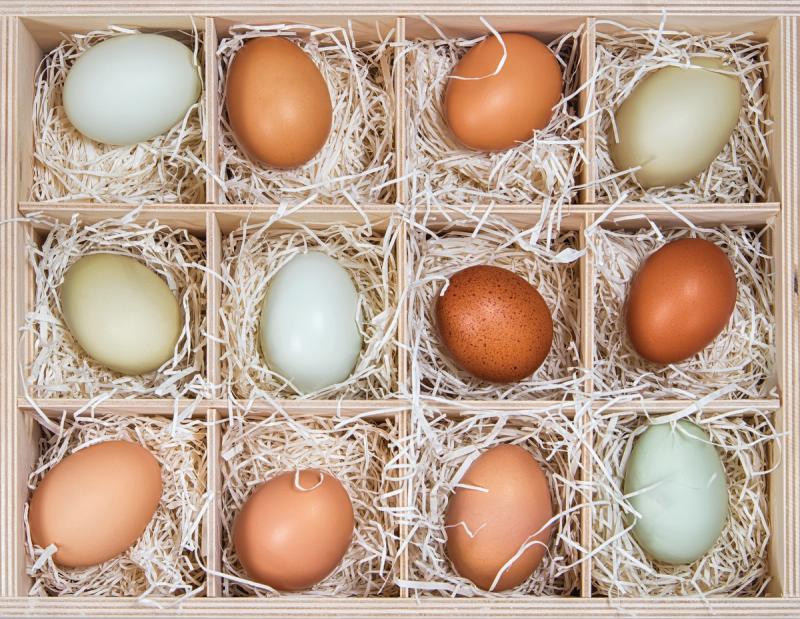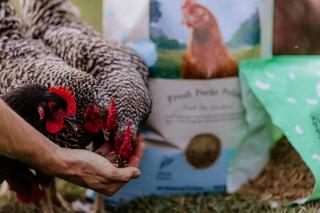Unveiling the Egg Rainbow
Discover the Colors Chickens Lay


As a chicken enthusiast eagerly anticipating the first colorful eggs from your flock, the mystery behind the colorful hues can be as captivating as the eggs themselves.
The fascinating world of chicken egg colors, the breeds that produce them, the factors influencing color variations, and even whether egg color affects flavor, are important facts every chicken keeper needs to know.
Shell color is hereditary, and the bird’s breed defines the color of the eggs the hen will lay. Two genes — brown and blue — determine color. When both these genes are absent, the shell color is white. Modifying the genes creates different shades of color.
Over the years, different breeds have been selectively crossed, resulting in various breeds that lay an assortment of egg colors.
Exploring Egg Colors and Their Origins
From the vibrant blues of Araucanas to the rich browns of Marans, each hen contributes its unique signature to the spectrum of egg colors. The breed dictates the pastel pinks, olive greens and even speckled eggs that adorn your coop, adding a touch of diversity to your egg collection.
The depth of shell color pigment will depend on the laying qualities of the hen, with older hens frequently laying more pale eggs than younger hens. Pigment color may also be affected if the birds become stressed.
Beyond Aesthetics
Contrary to popular belief, egg color has no direct correlation with taste or nutritional value. However, the color of a chicken’s earlobes can offer insights into the potential shade of their eggs.
Earlobe Color Impacts Egg Color
Egg color is often correlated with earlobe color! The rule of thumb is that red earlobes equal brown eggs and white earlobes equal white eggs. However, there are exceptions!
Some exceptions to the rule are Aracanas and Ameraucanas, which lay blue eggs but have red earlobes. The traits aren’t linked genetically and can and have been sorted separately in selective breeding through the years.

Diet May Make a Difference
The saying “you are what you eat” rings true for humans and our feathered friends. The chicken’s diet can also influence the color of an eggshell. What they eat plays a crucial role in shaping the color of the eggs they lay.
One key factor in eggshell coloring is the presence of pigments called carotenoids. These natural compounds are found in various foods like grass, flowers, fruits and vegetables that chickens consume.
For instance, hens with access to a diet rich in carotenoids may lay eggs with vibrant orange or yellow yolks and even darker-colored eggshells.
Another essential dietary component affecting egg color is the level of xanthophylls in the feed. Xanthophylls are yellow pigments commonly found in corn, alfalfa and marigold petals.
When hens consume feed high in xanthophylls, they can deposit these pigments into the egg yolk, resulting in eggs with a deeper yellow or orange hue.
The protein content of a chicken’s diet can also impact eggshell color. A balanced diet with sufficient protein can produce stronger eggshells with more intense colors. On the other hand, deficiencies in essential nutrients like calcium or vitamin D can lead to paler eggshells or even shell abnormalities.
Myths
- Brown eggs are more nutritious — this is false. Egg color only affects the outermost layer of the eggshell and has no impact on nutritional value.
- Quality of the chicken — also false. The color of the shell doesn’t correlate to the taste of the egg.
- Blue egg color means your chicken has a virus — this is false as well. Blue egg color is caused by genetics.
In some cultures, the color of a chicken egg is believed to signify good luck or fertility.
Egg-citing times lie ahead as you anticipate the first burst of colors from your chickens, adding a touch of whimsy and wonder to your daily egg collection routine.
Breed Egg Colors
- The Araucana: Blue eggs.
- Orpington: Brown eggs.
- Australorp: Brown eggs.
- Rhode Island Red: Brown eggs.
- Faverolle: Cream eggs.
- Wyandotte: Brown eggs.
- Easter Egger/Americana: Varies; any color is possible.
- Aracana: Blue eggs.
- Olive Egger: Dark green eggs.
- Legbar: Blue eggs.
- Marans: Dark Chocolate eggs.
- Leghorn: White eggs.
- Isa Brown: Brown eggs.
- Silkie: White eggs.
- Polish: White eggs.
- Frizzle: Egg color varies.
Tags:Chicken Scratch

Chicken Whisperer is part of the Catalyst Communications Network publication family.












